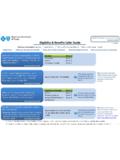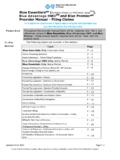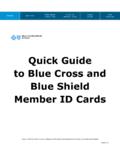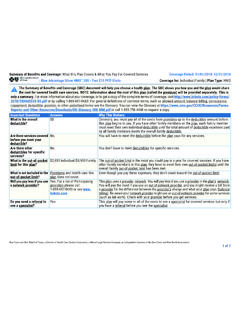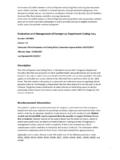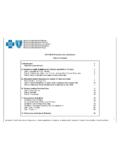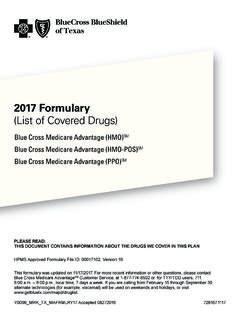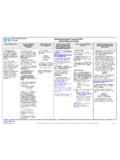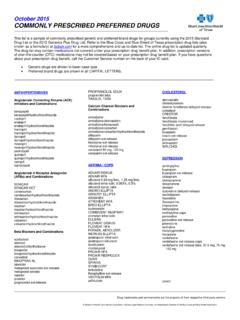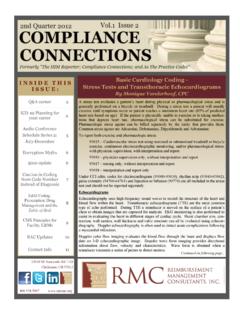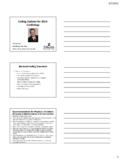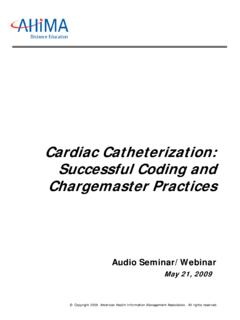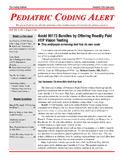Transcription of Inpatient Unbundling Policy - Blue Cross Blue …
1 1In the event of conflict between a Clinical Payment and coding Policy and any plan document under which a member is entitled to Covered Services, the plan document will govern. Plan documents include, but are not limited to, Certificates of Health Care Benefits, benefit booklets, Summary Plan Descriptions, and other coverage documents. In the event of conflict between a Clinical Payment and coding Policy and any provider contract pursuant to which a provider participates in and/or provides services to eligible member(s) and/or plans, the provider contract will govern. Inpatient Unbundling Policy Policy Number: CPCP002 Version Enterprise Clinical Payment and coding Policy Committee Approval Date: 03/30/2017 Effective Date: 07/24/2017 Last Updated: 03/30/2017 Description: The purpose of the Inpatient Unbundling Policy is to document a payment Policy for covered medical and surgical services and supplies.
2 Health care providers (facilities, physicians and other health care professionals) are expected to exercise independent medical judgment in providing care to patients. The Inpatient Unbundling Policy is not intended to impact care decisions or medical practice. Providers are responsible for accurately, completely, and legibly documenting the services performed. The billing office is expected to submit claims for services rendered using valid codes from HIPAA-approved code sets. Claims should be coded appropriately according to industry standard coding guidelines (including but not limited to UB Editor, AMA, CPT, CPT Assistant, HCPCS, DRG guidelines, CMS National Correct coding Initiative (CCI) Policy Manual, CCI table edits and other CMS guidelines). Reimbursement Information: A claim review conducted on an itemized statement involves an examination of that statement and the associated medical records for Unbundling of charges and/or inappropriate charges.
3 CMS s Provider Reimbursement manual, chapter 22, section , defines routine services as those services included by the provider in a daily service charge sometimes referred to as the room and board charge. Routine services are composed of two broad components: (1) general routine service, and (2) special care units (SCU), including coronary care units (CCU) and intensive care units (ICU). Included in routine services are the regular room, dietary services, nursing services, minor medical and surgical supplies, medical social services, psychiatric social services, and the use of certain equipment and facilities for which a separate charge is not applicable. 2 Equipment commonly available to patients in a particular setting or ordinarily furnished to patients during the course of a procedure, even though the equipment is rented by the hospital, is considered routine and not billed separately.
4 Special Care Units must be equipped or have available for immediate use, life-saving equipment necessary to treat critically ill patients. The equipment necessary to treat critically ill patients may include, but is not limited to, respiratory and cardiac monitoring equipment, respirators, cardiac defibrillators, and wall or canister oxygen and compressed air. Routine supplies are included in the general cost of the room where services are rendered. These items are considered floor stock and are generally available to all patients receiving services. As routine supplies, they cannot be billed separately. Examples include drapes, saline solutions and reusable items. The UB-92 Editor uses the following guide to determine if an item can be separately billed. You must be able to answer yes to the following questions: Is the supply medically necessary and furnished at the direction of a physician ( , not personal convenience items such as slippers, powders, lotions, etc.)
5 ? Is the supply used for a specific patient (excluding gowns, gloves, and masks used by staff)? Is the supply not ordinarily used for or on most patients (excluding blood pressure cuffs, thermometers and patient gowns)? Is the supply not basically a stock (bulk) supply (excluding drapes, pads, cotton balls, urinals, bedpans, bed linen and gauze)? Routine services and supplies are included by the provider in the general cost of the room where services are being rendered or the reimbursement for the associated surgery or other procedures or services. As such, these items are considered non-billable for separate reimbursement and are not eligible to be included in outlier calculations for additional reimbursement. The following guidelines may assist hospital personnel in identifying items, supplies, and services that are not separately billable.
6 This is not an all-inclusive list. Any supplies, items and services that are necessary or otherwise integral to the provision of a specific service and/or the delivery of services in a specific location are considered routine services and not separately billable in the Inpatient and outpatient environments. All items and supplies that may be purchased over-the-counter are not separately billable, excluding medications. All reusable items, supplies and equipment that are provided to all patients during an Inpatient or outpatient admission are not separately billable. All reusable items, supplies and equipment, such as pulse oximeter, blood pressure cuffs, bedside table, etc., that are provided to all patients admitted to a given treatment area or units are not separately billable. All reusable items, supplies and equipment that are provided to all patients receiving the same service are not separately billable.
7 3 1. Routine Supplies - The hospital basic room and critical care area room (cardiac, medical, surgical, pediatric, respiratory, burn, neonate (level III and IV), neurological, rehabilitative, post-anesthesia or recover, and trauma) daily charge shall include all of the following services, personal care and supply items and equipment: Admission, hygiene, and or comfort kits Soap Alcohol swabs Arterial blood gas kits Baby powder Band-aids Basin Bedpan, regular or fracture pan Blood tubes Cotton balls, sterile or nonsterile Deodorant Drapes Emesis Basin Gloves used by patients or staff Gowns used by patents or staff Heat light or heating pad Ice packs Irrigation solutions Items used to obtain a specimen or complete a diagnostic or therapeutic procedure IV arm boards Kleenex tissues Lemon glycerin swabs (flavored swabs) Lotion Lubricant Jelly Masks used by patients or staff Meal Trays Measuring pitcher Mid-stream urine kits Mouth care kits Mouthwash Needles Odor eliminator/ Room deodorizer Oral Swabs Oxygen masks Pillows Preparation kits Razors Restraints Reusable sheets, blankets, pillowcases, draw sheets, underpads, washcloths and towels Saline solutions Shampoo Sharps containers Shaving Cream Skin cleansing liquid Socks/Slippers Specipan Syringes Tape Thermometers Toilet tissue Tongue depressors Toothettes, oral swabs Toothbrush Toothpaste Trap Sputum Urinal Water pitcher 4 2.
8 Medical Equipment - The hospital basic room and critical care area room (cardiac, medical, surgical, pediatric, respiratory, burn, neonate (level III and IV), neurological, rehabilitative, post-anesthesia or recover, and trauma) daily charge shall include all of the following services, personal care and supply items and equipment: Ambu bag Aqua pad motor Arterial pressure monitors (inclusive of Critical Care room charge only) Auto Syringe Pump Automatic thermometers and blood pressure machines Bed scales Bedside commodes Blood pressure cuffs Blood warmers Cardiac monitors CO2 monitors Crash Cart Defibrillator and paddles Digital recording equipment and printouts Dinamap Emerson pumps Fans Feeding pumps Flow meters Footboard Glucometers Gomco pumps Guest beds Heating or cooling pumps Hemodynamic monitors (inclusive of Critical Care room charge only) Humidifiers Infant warmer IV pumps; single and multiple line; tubing Nebulizers Overhead frames Over-bed tables Oximeters/Oxisensors- single use or continuous Patient room furniture.
9 Manual, electric, semi-electric beds PCA pump Penlight or other flashlight Pill pulverizer Pressure bags or pressure infusion equipment Radiant warmer Sitz baths Stethoscopes Telephone Televisions Traction equipment Transport isolette Wall Suction, continuous or intermittent 5 3. Facility Basic Charges The hospital basic room and critical care area room (cardiac, medical, surgical, pediatric, respiratory, burn, neonate (level III and IV), neurological, rehabilitative, post-anesthesia or recover, and trauma) daily charge shall include all of the following services, personal care and supply items and equipment: Administration of blood or any blood product by nursing staff (does not include tubing, blood bank preparation, etc.) Administration or application of any medicine, chemotherapy, and/or intravenous fluids Assisting patient onto bedpan, bedside commode, or into bathroom Assisting physician or other licensed personnel in performing any type of procedure in the patient s room, treatment room, surgical suite, endoscopy suite, cardiac catheterization lab; or x-ray Bathing of patients Body preparation of deceased patients Cardiopulmonary resuscitation Changing of dressing, bandages and/or ostomy appliances Changing of linens and patient gowns Chest tube maintenance, dressing change, discontinuation Enemas Enterostomal services Feeding of patients Incontinent care Insert, discontinue, and/or maintain nasogastric tubes Intubation Maintenance and flushing of J-tubes; PEG tubes; and feeding tubes of any kind Management or participation in cardiopulmonary arrest event.
10 Obtaining and recording of blood pressure, temperature, respiration, pulse, pulse oximetry Medical record documentation Monitoring and maintenance of peripheral or central intravenous lines and sites to include site care, dressing changes, and flushes Monitoring of cardiac monitors; CVP (central venous pressure) lines; Swan-Ganz lines/pressure readings; arterial lines/ readings; pulse oximeters; cardiac output; pulmonary arterial pressure Neurological status checks Nursing care Obtaining and recording of blood pressure, temperature, respiration, pulse, pulse oximetry Obtaining of: finger-stick blood sugars; blood samples from either venous sticks or any type of central line catheter or PICC (peripherally inserted central catheter) line; urine specimens; stool specimens; arterial draws; sputum specimens; or any body fluid specimen Oral care Oxygen Patient and family education and counseling Preoperative care Set up and/or take-down of: IV pumps, suctions, flow meters, heating or cooling pumps, over-bed frames; oxygen; feeding pumps; TPN; traction equipment; monitoring equipment Shampoo hair Start and/or discontinue intravenous lines Suctioning or lavaging of patients Tracheostomy care and changing of cannulas Transporting, ambulating, range of motion, transfers to and from bed or chair Turning and weighing patients Urinary catheterization Venipuncture 6 4.
